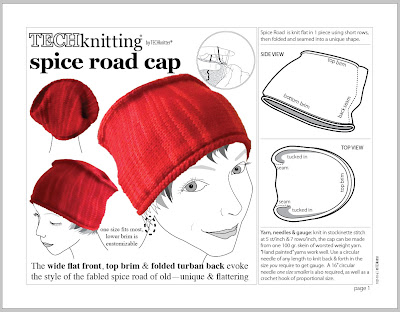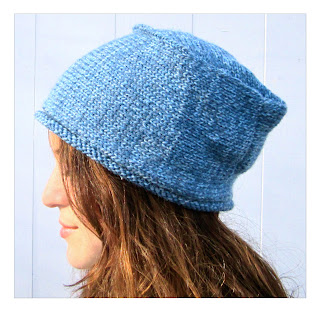This post--the third in a TECHknitting series on buttonholes*--shows how to make the sheepseye buttonhole. Some folks call this buttonhole the "yarn over buttonhole," but I don't, because you can make a smaller, tighter version of this same buttonhole by skipping the yo altogether.
Sheepseye (aka "yarn over") buttonhole
Sheepseye (aka "yarn over") buttonhole
Row 1: a k2tog (red) is followed by a yo (black), then work as your pattern requires, to the end of the row. Turn work.
Row 2: work all stitches including the yo, in the fabric called for by your pattern.
When you keep making these, spaced out as required, and always in the same column as you knit, the resulting is a line of little round buttonholes up the front band of a sweater. Although rather rough, this “sheepseye” buttonhole is remarkably easy to work and has the distinction of being the smallest buttonhole which can be worked in a given fabric—a good match for the small buttons suitable to delicate work or baby garments.
Tightening the sheepseye by skipping the yarn over
For tighter sheepseyes, skip the yo. Here's how:
Row 1: K 2tog. Next, place a safety pin around (not through!) the yarn after the k2tog. Work the following stitches as you usually would. Turn work
Row 2: Work as pattern requires. When you get to the place where the pin is, use the pin to lift the “bar” onto your L needle, remove the pin, then knit the bar. Continue working the remainder of the sts as called for by your pattern.
If row 2 makes no sense to you, no worries: here is a fuller description. When you get to where the pin is, pull up on the pin. You'll see that you're pulling on a sort of a loop which arises between two stitches. This loop is called a "bar." Deposit the bar onto the left needle. Next, remove the pin and you will see that you've created a sort of an afterthought yo, pulled up out of the yarn in the row below. This trick is sometimes called "lifting a bar." Knit into this bar just as if it were a yo, then knit the rest of the sts as usual.
Here's why this trick works: if you HAD made a yo, you would have added that amount of yarn to your fabric. By skipping the yo and lifting a bar from the row below instead, you are pulling slack out of an already-knit fabric. This forces the fabric to tighten. By knitting into this bar, you are creating a hole in the same place as it would have been had you made a yo, but it is a smaller hole than you ever could have knit using a yo--perfect for small slippery round buttons, such as pearl buttons, for example. Knitting into the bar also corrects the st count just as if you'd knit into a yo made in the previous row.
Nifty, ay?
Two caveats:
Good knitting!--TK
PS: There is a new (September 2013) YO (eyelet) buttonhole which is reinforced, a better choice if you need sturdier version. Have a look! Thanks to Ellen at at Pile of Sheep Blog for this new trick.
For tighter sheepseyes, skip the yo. Here's how:
Row 1: K 2tog. Next, place a safety pin around (not through!) the yarn after the k2tog. Work the following stitches as you usually would. Turn work
Row 2: Work as pattern requires. When you get to the place where the pin is, use the pin to lift the “bar” onto your L needle, remove the pin, then knit the bar. Continue working the remainder of the sts as called for by your pattern.
If row 2 makes no sense to you, no worries: here is a fuller description. When you get to where the pin is, pull up on the pin. You'll see that you're pulling on a sort of a loop which arises between two stitches. This loop is called a "bar." Deposit the bar onto the left needle. Next, remove the pin and you will see that you've created a sort of an afterthought yo, pulled up out of the yarn in the row below. This trick is sometimes called "lifting a bar." Knit into this bar just as if it were a yo, then knit the rest of the sts as usual.
Here's why this trick works: if you HAD made a yo, you would have added that amount of yarn to your fabric. By skipping the yo and lifting a bar from the row below instead, you are pulling slack out of an already-knit fabric. This forces the fabric to tighten. By knitting into this bar, you are creating a hole in the same place as it would have been had you made a yo, but it is a smaller hole than you ever could have knit using a yo--perfect for small slippery round buttons, such as pearl buttons, for example. Knitting into the bar also corrects the st count just as if you'd knit into a yo made in the previous row.
Nifty, ay?
Two caveats:
- When you lift the bar to form the afterthought yo, lay it on your left needle oriented the same way as if it were an actual yo (look at the orientation of a yo made on a swatch for comparison). Work into this bar-yo without twisting it. In other words, do not twist the hole shut by knitting into the back of the lifted bar, thus criss-crossing the st shut over where the hole should be.
- Try both the yo way and the non-yo way of making these buttonholes on a swatch, then try pushing through the button you're planning to use. No sense in over-tightening the buttonhole so the button no longer slides through.
* * *
Good knitting!--TK
PS: There is a new (September 2013) YO (eyelet) buttonhole which is reinforced, a better choice if you need sturdier version. Have a look! Thanks to Ellen at at Pile of Sheep Blog for this new trick.
(You have been reading TECHknitting
*(Posts in this series)
.Buttonholes in hand knitting, part 1: lore and tradition plus some nifty tricks
__________________
*(Posts in this series)
.Buttonholes in hand knitting, part 1: lore and tradition plus some nifty tricks
(Related posts)








